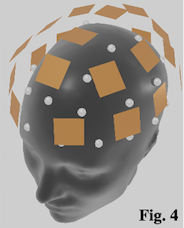
UE project / CEREBRO
Imaging the brain activity is fundamentally important for many brain-related scientific disciplines. Among the non-invasive neuroimaging strategies, Electroencephalography (EEG) from scalp potentials is one of the primary. In EEG the neuron- induced electric potential is measured by using electrodes on the patient’s scalp. The skull however, highly resistive, shields EEG recordings limiting the spatial resolution. The standard way to avoid skull shielding effects is to invasively implant EEG electrodes under the skull (ECoG) or in the brain cortex (StereoEEG), in both cases after trepanning the patient’s skull. Scalp EEGs are noninvasive but lack spatial imaging accuracy. ECoG and StereoEEG are highly accurate but require skull trepanation and they image only a limited part of the brain. There is the need for increasing the resolution of scalp EEG providing the same level of accuracy of invasive EEGs. This will be the grand challenge which CEREBRO will achieve by conceiving the first ever existing EEG contrast medium, able to provide imaging of the entire brain and in a non-invasive way.
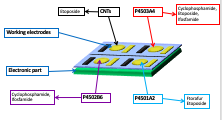
SNF project / Intelligent Platform for Drug Response in Precision Oncology
This project aims at developing a new portable device based on electrochemical sensors, pharmacokinetic models, and state-of-the art machine learning algorithms. This new device will be the very first ever-conceived single-device capable of fusing real-time data dealing with molecular concentrations in the patient’ blood and patient’ metadata to provide robust clinical recommendations for dosage adjustments in precision oncology. Therefore, the main objective is here to establish a new tool for precision oncology by developing a micro-fabricated system that integrates: electrochemical sensors for measuring several anticancer drugs commonly used in chemotherapy; all the electronic circuits required for sensors reading as well as for data elaboration and communication; local intelligence based on machine learning algorithms as implemented on hardware; dedicated fluidics to separate serum from patients’ blood. This final platform will be capable to provide the simultaneous detection of busulfan, methotrexate, 5-fluorouracil, cyclophosphamide, ifosfamide, and etoposide with a single multi-panel device.
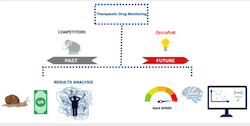
Innosuisse project / Onco-PoK a MEM-TDM-nanosensor for imatinib
Development of an innovative point of care nanobionsensor for precise and instantaneous measurement of anti-cancer small molecules concentration in the blood combined with an intuitive display of the results for oncologists in the context of therapeutic drug monitoring for cancer targeted therapies.

EPFL/UM6P Program “Excellence in Africa“
Final objective of the program is to create the proper conditions for them to produce outstanding PhD research. More generally, the program will contribute to the emergence of a new generation of talented young researchers in Africa and to nurture excellence in the academic sector throughout the continent. In particular, we will use Additive manufacturing by bioplastic from agricultural wastes and recycled plastics, and then optimize the 3D printing process parameters for development of biomedical devices, including biosensors. We will also develop Iron oxide nanocomposites for development of innovative devices for detection and removal of pollutant from clear water.
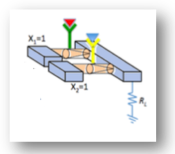
SNF project / In-Memory Sensing
Von Neumann computation provided to humanity an enormous advantage allowing the spreading of computational power all around the world, nowadays largely embedded in personal electronics too (e.g., personal computers, tablets, smartphones, smartwatches, etc.). Von Neumann machines are based on an architectural concept that is based on storing data as physically separated by the core of computation. Typical examples are modern personal computers where computation is done in the CPU (Central Processing Unit) while data are stored in memories (e.g., Random-access memories, cash memories, non-volatile storage device, etc.). However, moving data from memory to processing units is “time consuming”, and represents a bottleneck in computation, while Deep Learning machines exploit a kind of computation based on neural networks. Memristors seem “naturally close” to biological neurons in term of functionality, since they fuse the concept of storing and computing in a single device. Therefore, the aim of this Swiss NSF funded project is to design, realize, and demonstrate the very-first ever-proposed architecture for a new computation machine enabling the concept of “in-memory sensing”: it will automatically provide more than the present edge- computing since, since the computation will be done in the sensors, not close to the sensor.
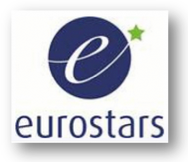
Eurostar Project / NUTRISENS
Development and characterization of the individual ion selective ISFET sensors and their integration into a multi-ISFET sensor head. New membranes for selected ions (e.g., K+, NO3–, NH4+, and H2PO4–) are realized based on the recipes used for already established ion-selective membranes. Adapting ionophore-bearing, selective membranes to MICROSENS’ ISFET devices with dedicated selective membrane synthesis, deposition, and testing with respect the specifications required by the application of water-plants monitoring.
The packaging of multi-ISFET probes, holding individual sensors, will be designed and realized as will its housing. The design of the latter is dedicated by the constraints given by the micro FLOAT. The multi-sensor module together with an integrated miniature reference electrode will then be evaluated with respect to the basic NUTRISENS specifications
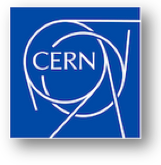
Radiation-Tolerance Humidity-Sensor for High-Energy Physics
The “next” generation (after 2025) of high-energy Physics detectors are going to be even more silicon-based. The number of channels is surpassing the billion (for a volume of ~20 m3) with very high current densities and power consumption close to 250 kW. Cooling is then indispensable both for removal of the produced heat and for avoiding thermal runaway due to the temperature increase induced by the sensor leakage current. The cooling temperatures will range between -35 and -25 degrees Celsius. At those temperatures, vapour condensation may result in dramatic detector’s damages. In order to prevent damages by vapour condensation, relative humidity needs reliable and detailed monitoring. To be accurate the dew point temperature has to be monitored but the detectors are equipped with millions of radiation hard temperature sensors that can be combined with a relative humidity measurement in order to give the dew point value. However, the performance of any relative humidity sensor operating in high-energy detectors is highly degraded. Therefore, the main goal of this research is to develop the humidity sensor that will survive in such an environment.
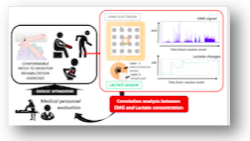
SWEASE
(Smart WEArable Sensors for E-Health applications)
The SWEASE project is a networking project born and funded by the Department of Information Engineering of the University of Padova. The project exploits the combination of emerging printed electronics techniques (e.g. Aerosol Jet Printing), nanotechnologies, advanced front-end designs, processing techniques and on-field validation strategies to make a step ahead in the robust continuous monitoring of muscular activity and fatigue during rehabilitation exercises. The activities focus on design and fabrication of customized printed flexible and stretchable wearable sensors able to non-invasively and simultaneously measure electromyographic signals (EMG) and lactate concentration in sweat during muscular activity. Taking advantage of a portable wireless front-end, the combined information driven from the sensors during specific muscular exercises will be then processed to provide a useful feedback in rehabilitative sessions, to prevent fatigue and improve exercises personalization and effectiveness.
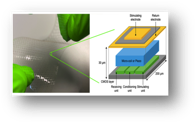
Smart Neural Dust to Revert Blindness
Visual prostheses are used to revert blindness: a medical condition affecting more than 39 million people worldwide (WHO). So far retinal prostheses showed the best performances in clinical trial on patients. However, one of the main limitations is the low resolution as due to the limited number of electrodes that can be addressed with wires. Therefore, we propose an innovative neurostimulation by wireless device is an array of thousands freestanding, ultra-small, and individually addressable CMOS-pixels (200 x 200 x 30 μm3), as a kind of Body-Dust embedded into a conformable mesh for easy surgical placement in human visual cortex

GlucoRaman
(Compact Glucose Sensing Using Vibrational Imaging)
With diabetes as a major disease issue for many people all around the world, the regular monitoring of the blood glucose level remains the only way to avoid severe secondary health complication through controlled insulin administration. However, present way to measure glucose level in diabetic patients is quite invasive techniques like the fingerstick testing. Therefore, we plan here the development of new and fully non-invasive blood glucose monitoring techniques that would improve significantly the life quality of diabetic subjects and help early detection and prevention of diabetes for the healthy ones
BCI Former Projects
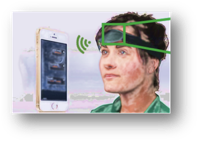
Cybercare
(Integrated Sensing Architectures and Tools for Health Care)
This research project addresses high-risk, high-reward research of integrated sensing and computing architectures, as well as of models, methods and tools for their design and operation. Such architectures provide the bridge between bio-systems and information processing systems. Breakthroughs in data acquisition, processing and decision making support will enable new smart-health applications. This project also aims at the development of wearable multi-sensing platform for ion-sensing. Sweat is used here as main sample fluid because it represents a promising substitute to blood thanks to the simple artificial reproducibility and to the large accessibility that does not require invasive or painful procedures

CoMofA2
(Monitoring of Anesthetics – Project prolongation)
Precise measure and control of anesthesia remain challenging and could results in faulty drug administration. Proper anesthesia requires the achievement of a certain target plasma concentration of drugs, typically injected by Target Controlled Infusion (TCI) systems, with prediction errors in control models reaches 20-30% due to the patients’ diversity. Good improvement can come by frequent measure of the anesthetics in the patient’ blood as we have already demonstrated in a previous project on this research subject. Therefore, we target here the realization of a pen-based system for an easy-to-use, cheap-enough, and point-of-care monitoring of anesthetics (mainly propofol) in human fluids

CTI Microsense
(Integrated ion-sensor platform for remote monitoring of water network)
The company Microsens, a company of the EPFL Scientific Park, has more than 20 years experience on devices for water quality monitoring. On the other hand, École Polytechnique Fédérale de Lausanne, EPFL is currently developing electrochemical sensors for monitoring ions. Therefore, EPFL and Microsens would like to merge the ideas and technologies for investigation of innovative nano-sensors for continuous monitoring of the water quality. Electrochemical sensors are chosen because they can be easily integrated with electronics to provide automated monitoring in the field, including wireless transmission thank to an approach that we have already successfully demonstrated for medical applications
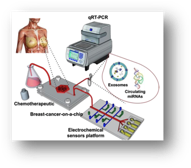
Breast cancer-on-a-chip with integrated sensors for drug screening
The goal of the present project is to design a breast-cancer-on-a-chip with integrated electrochemical sensors for circulating miRNA and exosome detection to test efficacy of chemotherapeutics. Herein, BC spheroids will be cultured 3D in PDMS based microfluidic bioreactor that is connected to multiple electrochemical sensors for on-line monitoring of biomarker secretion. The results obtained via EC sensors will be evaluated via additional methods such as qRT-PCR and ELISA and will provide the basis for future exosome and circulating miRNA detection from cell culture media since it will be the first study in literature. Overall, this project aims to open new approaches for chemotherapeutic screening and help prevention the global population suffering from breast cancer
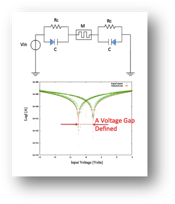
MemoCiS Memristors: Devices, Models, Circuits, Systems and Applications
The invention of the “transfer resistor”, or “transistor” as it is know today, is considered to be the greatest invention of the 20th century, as it forms the basis of all electronic systems. The next technological revolution will come through self-organizing and self-programming circuits and systems, which are similar to biological brains in that they can learn to perform tasks. This COST action is aimed at bringing together researchers of different backgrounds to work in unison so as to overcome multidisciplinary barriers in the area of memristors. The creation of the hardware basis for future self-organizing/self-programming systems will really open up a wide range of application areas and new industries, e.g. humanoid robots to look after the elderly, self-driven vehicles etc..
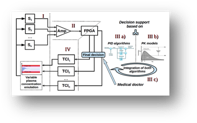
CoMofA: Continuous Monitoring of Anesthetics
Every year, 30,000 people undergo anesthesia and remain awake, still feeling pain while not being able to move, due faulty drug administration. Proper anesthesia requires the achievement of a certain target plasma concentration of drugs, typically injected by Target Controlled Infusion (TCI) systems, with prediction errors in control models reaches 20-30% due to the patients’ diversity. Therefore, continuous monitoring of anesthetic agents circulating in body fluids would contribute to better individualization of patients’ management. We propose to create a system with a semi-closed-loop control for anesthesia delivery based on the anesthetics monitoring in human fluids

Pierre Fabre: Feasibility Study for Nicotine detection on skin sweat
The company PIERRE FABRE MEDICAMENT, IRPF is conducting a product development program regarding the detection of nicotine inside human perspiration. On the other hand, École Polytechnique Fédérale de Lausanne, EPFL is currently developing electrochemical sensors for monitoring biomarkers such as drugs, metabolites inside human perspiration. Therefore, EPFL and Pierre Fabre would like to merge the ideas and technologies for investigation of electrochemical sensor development for the detection of nicotine inside perspiration
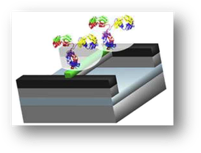
Reprogramming of Tie-2 Expressing Monocytes (TEM) in breast cancer
The key scientific purpose of this new project proposal is to understand the functional behavior of TEM in breast cancer in order to design optimal treatments able to reverse TEM into cells promoting protective anti-tumor immune responses. To this end, we will take advantage of our nanowire detection approach using multiplexed nanowire arrays sensing a panel of secretion markers reflecting TEM hemangiogenic, lymphangiogenic, immune suppressive, tumoricidal and anti-tumor activities. We plan also to use nanowire arrays to capture TEM landscape directly on the tumor tissue. This approach represents the first attempt to capture the tumor microenvironment leaving intact the tumor tissue for complementary characterization by confocal microscopy
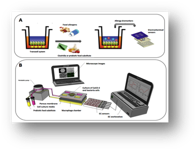
Food-Allergy-Chip: Bacterial/epitelial cell-culture platform to investigate the effect of probiotic foods on treatment of food allergy
Food allergy tests are done by Skin tests, including the prick test and the scratch test however, these tests are dangerous because of anaphylaxis by serum antibodies. Therefore, a safe, simple and rapid method for detecting allergic reaction is required for clinical use and in the food industry. A recent study on mice showed that common bacteria called Clostridia help prevent sensitization to food allergens in mice. Reintroduction of other type of bacteria (Bacteroides) did make the same effect on alleviation of food sensitivity indicating that Clostridia have a unique and protective role against food allergy. IL-22 that is known to be a key signaling molecule to decrease the permeability of the intestinal lining to prevent allergens to enter your bloodstream. Therefore, the aim of this project is to study food allergy and the effect of gut microbiome against food allergens by a Food-Allergy-Chip where electrochemical biosensors will monitor food-allergy biomarkers, including interleukin-22 (IL-22)

Parallel Sensing of Prostate Cancer Biomarkers
The Marie Curie Initial Training Network PROSENSE aims at training a new generation of young scientists in the interdisciplinary techniques and methods required to meet the major challenges in the development of diagnostic tools for prostate cancer. A full program of cross-disciplinary and cross-sectorial students exchange, training and events will enable PROSENSE to promote interaction, knowledge exchange and collaboration in the multidisciplinary field of biosensor design with the aim of developing improved devices for prostate cancer diagnosis, prognosis and treatments. Read more…

Pierre Fabre: Feasibility Study for Drugs Detection in Schizophrenia Therapy
The company PIERRE FABRE MEDICAMENT, IRPF is conducting a development program regarding new product with also organic small molecule with property as anti-cancer agent, exclusive property of PIERRE FABRE MEDICAMENT. On the other hand, the EPLF is currently developing devices that also integrate electrochemical sensors for the continuous monitoring of exogenous substances such as drugs, including compounds for schizophrenia treatment. Therefore, both parties joined the efforts to investigate the possibility to apply the technology under development in EPFL to the PIERRE FABRE’ products. Read more…
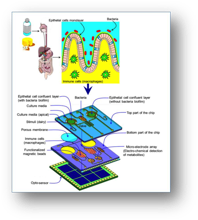
BactoChip: Bacteria/epithelial cell-culture platform to screen the metabolism of dairy products
The intestinal epithelium provides a selective barrier that protects the human organism from the invasion of pathogens and other undesired external factors but, at the same time, allows an efficient uptake of nutrients from the diet. In order to let macronutrients present in foods to be transferred across the intestinal barrier, the ingested macromolecules need to be broken into their building blocks. Recent research has demonstrated that commensal bacteria participate to a significant extend to the metabolism of nutrients by producing digestive enzymes as well as by influencing the intestinal transport of nutrients. We aim now to develop a new Lab-on-a-Chip platform (the BactoChip) that integrates a biofilm of a commensal E. coli strain to mimic the distal part of the intestine that is highly populated by bacteria
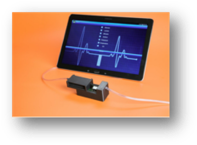
IronIC++
The project aims to develop a new system for continuous monitoring of critical patients in intensive care units (ICU). Patients in intensive care units are typically under the risk of fatal due to Systemic Inflammatory Response Syndrome (SIRS), a generic systemic response. If not treated within the first 48 h in ICU, it usually evolves to Multiple Organ Failure Syndrome (MOFS) and, then, in the death of the patient. However, commonly monitored physiological parameters do not allow early diagnosis and prediction of deterioration toward multiple organ failure. Therefore, this project aims to development of definitely new diagnostic tools capable of continuous monitoring of some critical metabolites in interstitial fluid (ISF) might significantly reduce mortality of these patients.
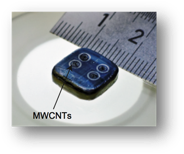
System for Drug Monitoring in Personalized Therapy
A fully mature biochip system capable of continuous monitoring drugs and biomarkers in blood, or in sub-cutaneous districts is under development and it constitutes a major breakthrough in molecular medicine for personalizing therapy of complex diseases. The aim of the present project is to undertake a multidisciplinary approach to substantially advance the state-of-the-art of implantable devices. The project requires a strong convergence between micro-nano-bio-medical technologies with the motivation to provide a new tool for the direct monitoring of the patient’s drug metabolism in personalized pharmacological treatments
A project news on Yahoo
A project clip on Reuters
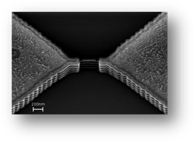
Memristive Biosensors based on silicon nanowires for Cancer Markers detection
This project proposes a new detection methodology based on memristive-effect registered on silicon nanowire to detect a new class of cancer markers. The nano-wires are fabricated by an innovative lithographic technique that allows precise and selective etching at the nanoscale. The wires are obtained in three main steps. Initially, a photoresist line defines the wire position. In a second step, silicon deep reactive ion etching is performed to obtain a scalloped trench. In the final step, the trench is reduced to a suspended nanowire after wet oxidation. The obtained wires present are functionalized with antibodies in order to sense the cancer markers on dried samples
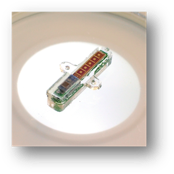
IronIC Project
The aim of this project is to study an innovative, multi-metabolites, highly integrated, fully implantable, and real-time monitoring system for human metabolism. The monitored metabolic molecules are not limited to lactate, glucose, ATP, Arachidonic Acid, Bilirubin, and others. To pursue this aim, the project is developing an innovative technology by integrating SW/HW/RF/micro/nano/bio systems in three devices: (i) a fully implantable sensors array for data acquisition; (ii) a wearable patch for remote powering and data acquisition; (iii) a Bluetooth connection to a smartphone.
A project clip on YouTube
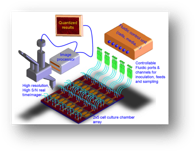
Nutrichip system for food quality control
The “NutriChip” project will combine biological sciences, nanotechnology, micro-technology and system integration aspects applied by a multidisciplinary team to develop an efficient analytical tool to gain holistic insight into the contribution of dairy products to human nutrition and health. Cells surface receptors called TLR2/4 were recently found to be down regulated in overweight and obese patients, and TLR4 is a receptor for dietary fat. So, a hardware interface is under development in order to detect TLR receptors in CaCo2 cells by combining a CMOS low-noise imager and required super-resolution algorithms
A summary on mediacom
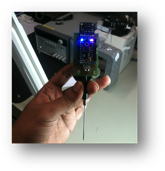
Intelligent Needles for Acupuncture Treatments
The project aims at the realization of an acupuncture i-needle for measuring Temperature, pH, and rotational velocity in animal tissues. A feasibility study is also conducted in order to evaluate the possibility to integrate molecular sensors in the i-needle I order to measure metabolites released in the extracellular matrix by the acupuncture treatment. Therefore, this project aims at providing a new tool to address the currently lacking systematic and scientific evidence of the physical and molecular mechanisms acting behind the acupuncture therapy
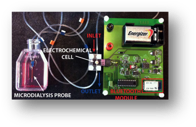
Biochip development for Cells Monitoring
A full system for metabolic monitoring cell cultures has been developed with the aim of on-line monitoring of cells with the aim but not limited to investigating stem cells growth and differentiation. The final device detects metabolic compounds released into the cell medium with a parallelism, sensitivity and velocity improved with respect to the state-of-the-art in cell monitoring. An iPad or a smartphone has been interfaced with the system in order to read, elaborate and organize the acquired data
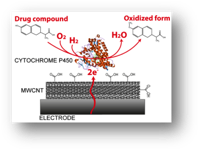
Nano-Bio-Chip Technologies for Sensing Applications
In this project, new enabling micro/nano/bio-technologies toward the development of all-on-chip systems for on-line biomonitoring have been explored for applications in: diagnosis, treatment of patients, cell cultures and environmental monitoring. The project comprises of three main research tasks: Nano-Bio films for applications in stem cells monitoring, Nano-Bio films for drugs detection, and innovative ideas in VLSI design for bio-applications